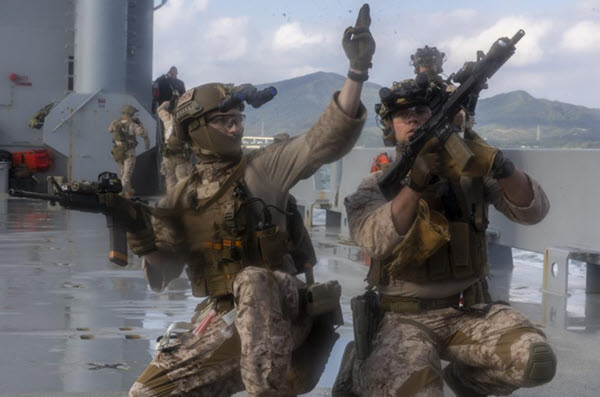
Okinawa, Japan. (January 26, 2023) In this photo by Sergeant Andrew King, U.S. Marines assigned to the Maritime Raid Force, 31st Marine Expeditionary Unit, post security on the USAV Calaboza during a visit, board, search, and seizure (VBSS) training off the coast of Kin, Okinawa.
VBSS training consists of boarding a vessel to systematically check all compartments for enemy personnel, weapons, or contraband. VBSS teams, like the Maritime Raid Force pictured above, are trained to capture enemy vessels, combat terrorism, stop piracy and smuggling, and to conduct customs, safety, and other inspections of suspect vehicles on the open sea.
That is no simple task.
To be a VBSS team member, a Marine must pass three courses on Close Quarter Battle (to develop proficiency in hand-to-hand combat tactics), search procedures, and tactical team movements. Students practice shooting, rappelling, searching, and arrest procedures for non-compliant combatants.
While all Sailors in the U.S. Navy are eligible to serve aboard a VBSS team, only those approved by their ship's command are considered. Being approved does not guarantee inclusion on a VBSS team, as it is possible (and not uncommon) for candidates to wash out of VBSS school which has an attrition rate of up to 30 percent.
U.S. Navy VBSS teams are generally armed with M4 carbines, Mossberg 500 shotguns, and Beretta M9 pistols. They wear Kevlar body armor and a buoyant tactical vest that doubles as a life preserver. The majority of U.S. naval ships deploying with VBSS teams are smaller, such as destroyers or cruisers, who are the most effective to combat illegal narcotics, arms trafficking, and piracy.
These law enforcement activities maintain security and freedom of sea lanes worldwide.
The Calaboza is a large landing craft used to transport rolling and tracked vehicles, containers, and outsized and general cargo from ships offshore to shore and to areas that cannot be reached by oceangoing vessels (coastal, harbor, and intercoastal waterways).
These brave Marines risk their lives every day to ensure a free and safe passage on the open seas.


